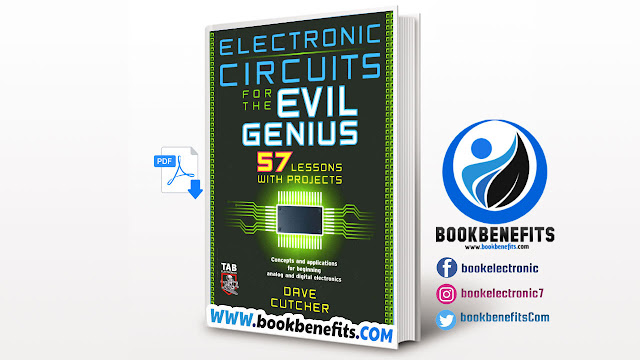Download Electronic Circuits for the Evil Genius: 57 Lessons with Projects PDF
Electronic Circuits for the Evil Genius: 57 Lessons with Projects PDF
Picture Of The Book :
About Of The Book :
We quickly embrace technology in our everyday world.
Those who do not understand how it works obey. People who take the time to learn electronics are considered smart. You want to learn
How to manage electricity?
This text provides a solid introduction to the field of
electronics, both analog and digital. Electronic circuit
because Evil Genius is based on hand-work
use the wisdom in each of us Apps
introduced as you build a functional circuit. These circuits are modified and analyzed to help explain it
service equipment. Everything is worth it. The analysis
is done by observation, using a digital multimeter, and
using your computer as an oscilloscope. You will do two main tasks in the first quarter:
• Automatic night light
• Professional alarm quality
The rest of the text focuses on three points
projects, one per minute:
• Build digital toys with logic gates
• Design and develop applications using
digital counter circuit
• Applications of transistors and operational amps as construction progressed
two-way intercom system
The tutorial and prototype circuit are built on
books that focus on developing a strong foundation
around each of these main projects. You are working
from ideas to prototypes, creating the final product
1 Hope you enjoy working and reading
I like the book to develop them.
Contents Of The Book :
Part I Components
Section One Components
Lesson 1: Inventory of Parts Used in Part I
Lesson 2: Major Equipment
Lesson 3: Your First Circuit
Section Two Resist If You Must
Lesson 4: Reading Resistors\
Lesson 5: The Effect Resistors Have on a Circuit
Lesson 6: The Potentiometer
Lesson 7: Light-Dependent Resistors
Section Thrce More Components and Semiconductors
Lesson 8: Capacitors and Push Buttons
Lesson 9: Introducing Transistors
Lesson 10: The PNP Transistor
Lesson 11: Your First Project: The Automatie Night Light
Lesson 12: Specialized Transistors The SCR
Part 11 Introducing Digital Electronics
Section Four Digital Logic
Lesson 13: A Spoiled Billionaire
Lesson 14: The Basic Digital Logic Gates
Lesson 15: Integrated Circuits CMOS ICS
Section Five The First NAND Gate Circuit
Lesson 16: Building the First NAND Gate Circuit
Lesson 17: Testing the Input at Test Point 1
Lesson 18: Test Point 2-The NAND Gate Processor at Work
Lesson 19: Test Point 3-Introducing the Resistor Capacitor Circuit
Lesson 20: Test Point 4-The Inputs Are Switches Section Six Analog Switches for Digital Circuits
Lesson 21: Understanding Voltage Dividers
Lesson 22: Create a Light-Sensitive Switch
Lesson 23: The Touch Switch
Section Seven The NAND Gate Oscillator Knowledge, Design, Control
Lesson 24: Building the NAND Gate Oscillator
Lesson 25: Understanding the NAND Gate Oscillator
Lesson 26: Controlling the Flash Rate
Lesson 27: Create a Sound Output and Annoy the Person Next to You!
Lesson 28: Introducing the Oscilloscope
Lesson 29: Using a Transistor to Amplify the Output
Section Eight Digital Logic Design
Lesson 30: System Design
Lesson 31: Consider What Is Realistic
Section Nine Digital Logic Application
Lesson 32: Building Your Project
Part III Counting Systems in Electronics
Section Ten Introducing an Analog-to-Digital Converter
Lesson 33: Introducing Possibilities- Electronics That Count
Lesson 34: RC1-Creating the Switch
Lesson 35: Introducing the 4046 Voltage- Controlled Oscillator
Section Eleven The 4017 Walking Ring Counter
Lesson 36: Introducing the Walking Ring 4017 Decade Counter
Lesson 37: Understanding the Clock Signal and the 4017
Lesson 38: Controlling the Count by Using Reset and Enable
Section Twelve Running a Seven-Segment Display
Lesson 39: Introducing the Seven-Segment Display
Lesson 40: Control the Seven-Segment Display Using the 4511 BCD
Lesson 41: Decimal to Binary-The 4516
Lesson 42: Automatic Display Fade-Out
Section Thirteen Define, Design, and Make Your Own Project
Lesson 43: Defining and Designing Your Project
Lesson 44: Your Project: If You Can Define It, You Can Make It!
Part IV Amplifier Introduced and Applied
Section Fourteen What Is an Amplifier?
Lesson 45: Transistors as Amplifiers and Defining Current
Lesson 46: Defining Work, Force, and Power
Lesson 47: What Do I Have to Gain?
Defining Gain
Lesson 48: The World Is Analog, So Analog Is the World
Section Fifteen Exploring the Op Amp
Lesson 49: Alternating Current
Compared with Direct Current
Information Of The Book :
Title: Electronic Circuits for the Evil Genius: 57 Lessons with Projects
Size: 78,72 Mb
Pages: 226
Year : 2004
Format: PDF
Author: Dave Cutcher

